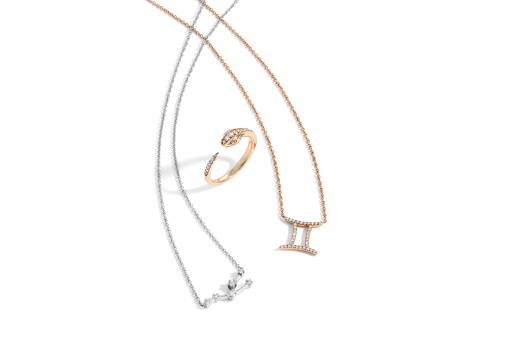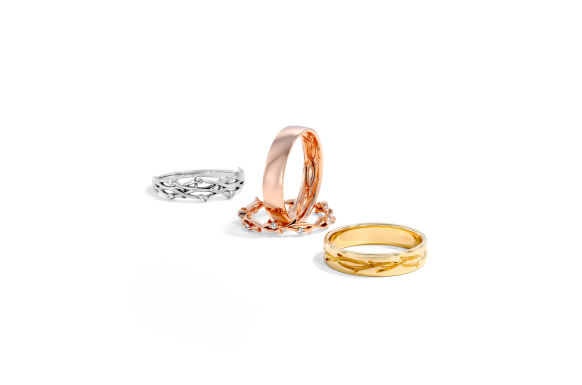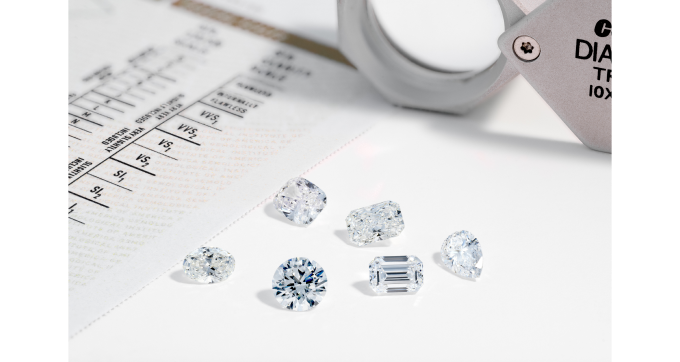Pear and marquise-cut diamonds are both appealing options for an engagement ring. With their unique and elongated shapes, they add a touch of drama that some find missing in more conventional diamond shapes. Both also have a slimming effect and a larger surface area compared to other cuts, which accounts for their popularity. However, they have some differences that might make one a better option for you than the other.
Whether you love the tear-drop elegance of the pear cut or the elongated symmetry of the marquise, this article will help you understand which cut might be the best choice for your ring.
Understanding Pear Cut Diamonds
Pear cut diamonds, also known as teardrop diamonds due to their unique shape, are a hybrid of the round and marquise cuts. They feature a rounded bottom with a tapered point at the top, creating an elegant and distinctive profile. This cut typically comprises 58 facets, allowing for significant brilliance and fire.
The pear cut, or pendeloque cut as it was initially known, has a rich history dating back to the 1400s. Its creation is credited to the Flemish cutter Lodewyk van Berquem of Bruges, who also introduced the concept of symmetry and the diamond-polishing wheel to the diamond cutting industry. The pear cut's unique shape and elegance quickly gained popularity, and it became a preferred choice for royalty and nobility.
Exploring Marquise Cut Diamonds
The marquise cut, characterized by its boat-like shape with pointed ends, is a modified brilliant cut diamond. Its elongated shape has 58 facets, offering a balance of sparkle and size. The elegant, pointed tips of this cut create a dramatic and distinctive silhouette that's unique in the world of diamond shapes.
Also known as the "navette" cut, the marquise cut dates back to the 18th century and is steeped in royal history. The shape was commissioned by King Louis XV of France who wanted a diamond cut to resemble the lips of his mistress, the Marquise de Pompadour. The cut was then named "marquise" in her honor. In more modern times, the marquise cut has been a popular choice for those looking for a distinct and dramatic diamond that stands out from traditional round or square cuts.
Face-Off: Pear vs. Marquise
Let’s start by comparing how they look on the finger.
-
Width and Length Proportions: Both the pear and marquise cuts have an elongated shape that tends to make the finger appear longer and more slender. However, the pear cut has a more rounded base which can make it look a bit wider than a marquise cut of the same carat weight. On the other hand, the marquise cut has a consistently narrow shape that may appear longer and more symmetrical.
- Hand Coverage and Visual Impact: Due to its length and size, a marquise cut tends to offer more hand coverage than a pear cut, making your fingers appear longer and more graceful. However, the rounded end of the pear cut gives it a softer appearance, which can be just as striking in a different way.
Now let’s take a look at how they compare in the sparkle and brilliance department!
-
Faceting Differences and Light Performance: Both the pear and marquise cuts are modified brilliant cuts, which means they are designed to maximize the diamond's sparkle. They both have similar facet counts, leading to higher brilliance. However, light performance can vary based on the quality of the cut.
- Impact on Overall Aesthetics: The way light interacts with each cut significantly impacts its aesthetics. Both cuts can offer stunning sparkle, but this largely depends on the quality of the cut and the stone's proportions.
Since both cuts have a lot going for them, your choice may be dictated by the size and shape of your fingers.
Pear Cut for Different Finger Shapes
Pear cut diamonds are especially flattering for those with chubbier fingers, which often appear shorter than they actually are. The elongated shape can create an illusion of length. For those with longer fingers, the rounded bottom provides a softer contrast and helps balance their appearance.
For individuals with wider fingers, a pear cut diamond can help make the fingers appear narrower. The key is to ensure the diamond's size is proportional to the hand. A too-small pear cut might appear lost on larger hands, while a too-large one might overwhelm petite hands.
In terms of settings, the following engagement ring styles show off the pear cut to its best advantage:
-
Halo Setting: A halo setting like The Kylie encircles the pear-cut diamond with a border of smaller accent stones. This style adds extra sparkle and creates the illusion of a larger center stone.
-
Nature-Inspired Settings: Consider settings that incorporate nature-inspired elements like leaves, vines, or petals to complement the soft curves of the diamond. By combining the teardrop shape of the stone with the nature-inspired setting, The Halo Twig creates a harmonious aesthetic.
- Vintage Settings: Pear-cut diamonds ‘pair’ beautifully with vintage-inspired rings like The Amber, which feature intricate filigree work or art deco motifs. These settings can add a touch of timeless elegance and charm to the ring.
Marquise Cut for Different Finger Shapes
With its elongated shape and pointed ends, the marquise cut creates the illusion of length and slimness. This makes it an ideal choice for shorter fingers, as it can visually extend their length. For those with long, thin fingers, a marquise cut can still look striking, especially in a setting that helps balance out finger length.
Here are some popular and attractive ring styles that work well with marquise diamonds. Since this cut is a showstopper, you want to choose a setting that shows off its best advantages:
- Three-Stone Setting: A three-stone setting like The Scarlett features a marquise-cut diamond at the center, flanked by two smaller stones on each side. This design can represent the past, present, and future of your relationship.
-
Side Stone Setting: With a side stone setting like The Victoria, the marquise diamond is bracketed by clusters of smaller diamonds or gemstones. This shimmering expansion makes the diamond appear larger on the finger.
-
Solitaire Setting: A simple and classic solitaire setting like The Lexie allows the marquise-cut diamond to take center stage. The minimal design puts the focus entirely on the diamond's brilliance and elongated profile.
Conclusion
Choosing between a pear and marquise cut diamond is really a personal decision, influenced by hand shape and style preference. The pear cut's soft curves may attract those who appreciate traditional elegance while the marquise cut's distinct symmetry might appeal to those looking for something more dramatic. Ultimately, the right choice is the one that makes your heart skip a beat.
Here at Keyzar, our experts will guide you through these decisions, ensuring that your engagement ring is absolutely perfect. You can use our virtual tools to design a ring that ticks all the boxes or even book a video appointment to check out online all the stones, settings, and styles available. With Keyzar's personalized service and cutting-edge technology, your dream engagement ring is just a click or conversation away, so reach out to us today.






